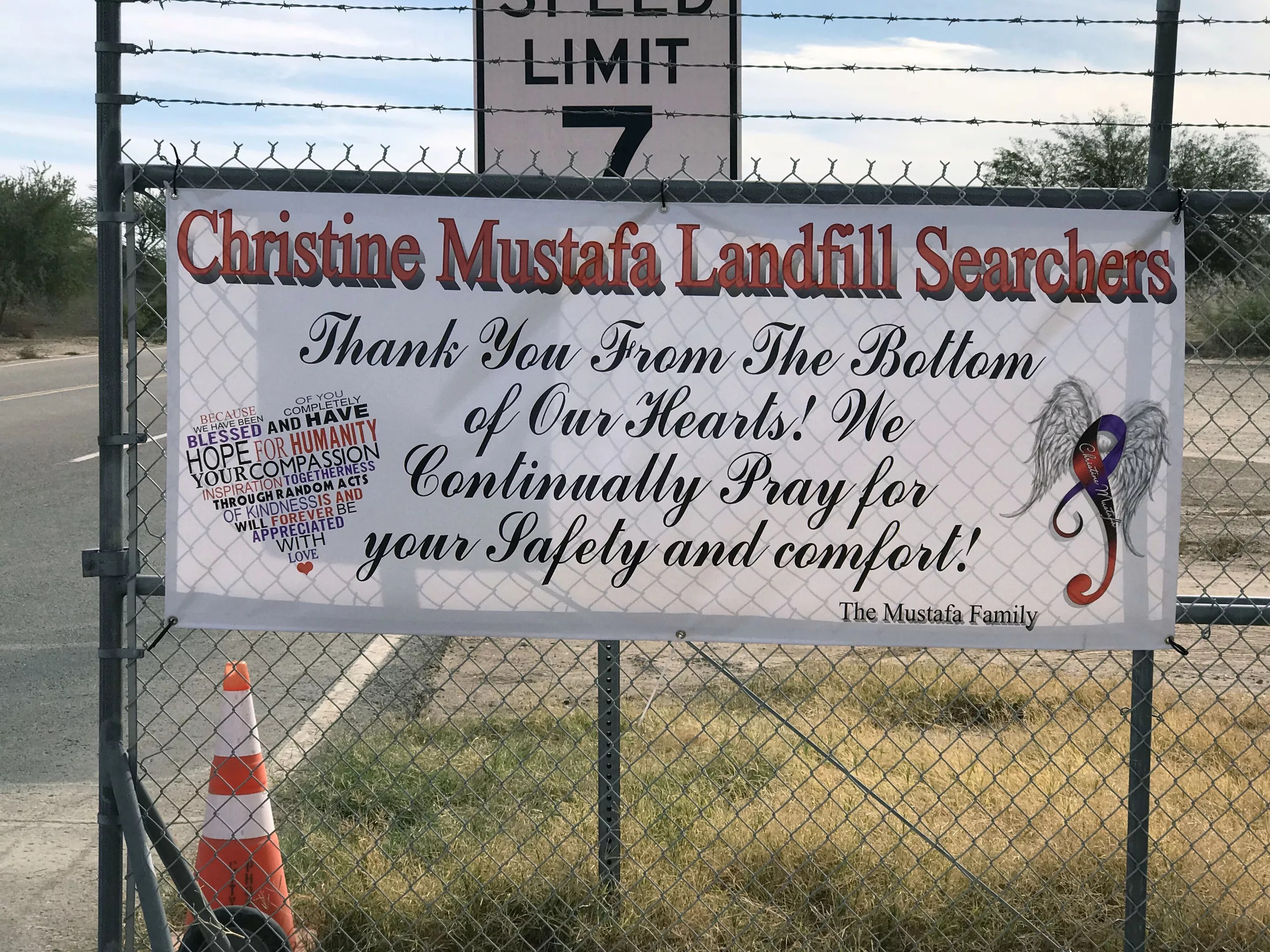
Sean Holstege

Audio By Carbonatix
No body, no crime.
You’ve probably heard that on TV crime shows. In Phoenix, some suspects believe it.
But it’s not always true, and it’s surprisingly less true in recent years, thanks largely to DNA and forensic science.
“If there’s no body, there’s no death,” Avelina Tamala told a friend.
We’re thankful for you. Are you thankful for us?
We feel thankful for our staff and for the privilege of fulfilling our mission to be an unparalleled source of information and insight in Phoenix. We’re aiming to raise $30,000 by December 31, so we can continue covering what matters most to this community.
Help us continue giving back to Phoenix.
In 2017, 20 years after Tamala and his girlfriend, Anna Reyes, dumped her 3-year-old daughter in the desert, Tamala was convicted of murder. Reyes fled to Mexico and remains on the lam.
Together they had often kept the pretty little girl, Crystal Reyes, in a dog crate. One night, they bound and gagged her and put her in a cardboard box. As the couple rode bikes, Crystal died in that box. It was all documented in “Crystal’s Cage,” an exceptional piece of journalism by the Arizona Center for Investigative Reporting.
Tamala was wrong. Ultimately, a hiker found a small fragment of Crystal’s skull, prompting a 20-year investigation into who she was, what happened to her, and who to blame.
Many cases, even successful ones, don’t even have a bone fragment. Some have nothing at all. But that doesn’t mean the investigation will fail.
Arizona has among the highest number of these “no-body” cases in the nation, including a current one that has led to a massive and expensive search.

Robert John Interval is charged with the murder of his missing girlfriend, Christine Mustafa.
Maricopa County Sheriff’s Office
A 38-year-old Phoenix man named Robert John Interval sits in county jail awaiting trial on murder charges. Phoenix police believe he killed his 34-year-old girlfriend, Christine Mustafa, and dumped her body.
Since late October, detectives have been searching a municipal landfill near Gila Bend for her body. Police say the search will likely cost more than $1 million by the time it wraps up in two weeks, even though successful landfill searches are rare.
Tad DiBiase tried 20 murders as a federal prosecutor from 1995 to 2007 in Washington, D.C., including one in which detectives never found a body. He later wrote a book and launched a website, nobodycases.com, as he became a consultant specializing in no-body homicide cases.
He called Phoenix’s landfill search “one of the most extensive” he’s ever seen.
For now, police have no body, no weapon, no cause or time of death, no witnesses, and no confession.
Still, DiBiase thinks the case against Interval is solid.
“It falls into a classic, textbook no-body case,” he said.
Textbook cases, DiBiase said, involve similar patterns. An event sets off the suspect. The suspect cleans up the crime scene. The suspect “moves on too soon,” by doing things that don’t make sense if he or she thinks the victim is merely missing.
This could be getting rid of personal effects or property, buying irrationally, moving, finding another romantic partner, and so forth. Sudden changes that don’t add up.
Half of all no-body murders involve people in close relationships, often spouses or romantic partners, but sometimes family members, DiBiase said. Often the suspect has a history of manipulating or controlling the victim.
Most of what we know about Mustafa’s disappearance and Phoenix detectives’ suspicions of Interval comes from a search warrant affidavit they filed in Maricopa County Superior Court.
The five-page document lays out the theory behind the case. Police say that on May 10, the night Mustafa was last seen alive near North 20th Place and East Robin Lane, Interval accused her of cheating on him, had repeatedly threatened to kill her, and that she threatened to take their baby.

Christine Mustafa is presumed dead.
Silent Witness
When police went to the house to check on Mustafa’s well-being, they found a bedroom with blood and DNA on the walls and bed, and signs Interval was cleaning up the home’s entryway.
He answered the door with a gun and lied about why Mustafa’s car was still there, police said. He tried to sell the car on Facebook the day she went missing, along with a mattress and a trailer he used to haul debris for his tree-trimming business.
Interval’s sister later told police he’d confided that he’d taken things too far and saw horrors he couldn’t blot out of his mind.
“It’s almost like you’re checking all the boxes,” DiBiase said of the case. “Even without a body, it’s a pretty strong case.”
Phoenix police have said the same thing, without elaborating.
DiBiase did.
“He seems like he’s got a bit of a big mouth,” he said of Interval.
Most convictions in no-body murder cases, DiBiase said, come from three sources: DNA or forensic evidence, confessions to police, or confessions to people close to the killer.
“People can’t help themselves,” DiBiase said. “Most are not hardcore killers and they do feel guilty and tell people. That’s not at all uncommon. Sometimes they brag because they are control freaks.”
Police have not shared any other details of the case. It remains unclear if they extracted any valuable evidence from Interval’s or Mustafa’s cellphones or computers.
DiBiase said details in the search warrant application probably lay out 90 percent of what detectives know. He added that defense attorneys usually argue either that the victim is missing, not dead, or that some other dude did it, the classic SODDI defense.
Interval’s attorneys are following the playbook.
“The circumstances of the case are unclear and it is difficult to ascertain exactly what happened in this case. There are theories provided by the state but those have not been corroborated,” Interval’s attorneys said in a pretrial motion. “The weight of evidence against the defendant is tenuous.”
Another hurdle for prosecutors in these cases is confirmation bias. Detectives laser in on an obvious suspect, but their tunnel vision stops them considering other plausible explanations.
“We feel we have a very good case. Obviously, we would like to have a body; not only for the case, but to give the family some closure.”
“I’ve seen it in investigations. Other suspects are clearly overlooked. Others are not murderers, but they are not properly excluded from the investigation,” DiBiase said. “If they haven’t excluded Killer X, that’s a problem.”
It’s a natural problem.
“It’s hard not to look the other way if you’ve got a guy leaving the house, who’s practically got blood dripping off his hands,” DiBiase said.
In Interval’s case, “the circle of suspects is pretty small,” DiBiase added.
Police say as much.
“To my knowledge, Mr. Interval was the only person suspected in this case,” Phoenix Police Sergeant Alan Pfohl said. “We feel we have a very good case. Obviously, we would like to have a body; not only for the case, but to give the family some closure.”
Surprisingly, once a no-body murder case goes to trial, prosecutors typically win, and more often than for homicides in general.
“The conviction rate is 89 percent in no-body cases. It’s 71 percent normally,” DiBiase said.
Arizona ranks sixth for (no-body) cases that went to trial, with 19. It’s the 14th most populous state.
Most of the convictions happened after 2000, with leaps in forensic science and DNA testing.
DiBiase has studied no-body homicide prosecutions back to the early 1800s. Arizona has an outsize place in those bloody annals.
Arizona ranks sixth for cases that went to trial, with 19. It’s the 14th most populous state.
The top five are: California (99 cases, most populous state), Florida (34 cases, third in population), New York (31 cases, fourth in population), Texas (26 cases, second in population), Michigan (23 cases, 10th in population).
There have been numerous cases, some high profile, of successful and unsuccessful murder investigations in Arizona in which a body was never found.
They are catalogued by the Charley Project, which says it profiles approximately 9,500 cold case missing people, mainly from the United States. The goal is to publicize the cases to stop them lapsing into neglect.
When 5-year-old Jhessye Shockley disappeared in Glendale in 2011, the case grabbed headlines. Detectives search the Butterfield Station Landfill in Mobile for four months, but never found the girl’s body.
Meanwhile, police suspected Jhessye’s mother, Jerice Hunter, amid reports of torture and abuse of her children and after witnesses said they saw her dump a foul-smelling suitcase in the trash in Tempe. Hunter always claimed innocence, but was convicted on murder charges in 2015, in part because detectives found traces of Jhessye’s blood on a closet carpet.
In Tucson, a jury similarly convicted Christopher Payne in 2009 on two murder counts. He was sentenced the death penalty. Police found the body of his daughter Ariana Payne inside a paid storage lockup, but never found the body of her brother, 4-year-old Tyler Payne, who was reported missing in March 2006.
The trial and court records showed that Christopher Payne was a heroin addict, owed nearly $20,000, starved the two children, and left Ariana with multiple broken bones. He admitted leaving her body in a closet, wrapped in a trash bag. Police thought Tyler was in a local landfill.

Cookie Jacobson
The Charley Project
In Tempe, police never solved a third case involving a landfill search, that of Cookie Sherron Jacobson, who vanished from Tempe in 1988 when she was 49. She was last seen near her house, where all her possessions and ID documents remained intact.
Her 16-year-old son Aaron told police he’d killed her and wrapped her in a yellow bedsheet and dumped her in the trash.
The trash can had blood on it, but not enough to prove a murder. Police searched the Butterfield Station Landfill for two months, but never found the body. The case was never solved.
The Charley Project lists eight other no-body homicides in Arizona. Three ended with convictions. In two others, police had suspects, but not enough evidence to charge them. One remains completely unsolved, with no suspects. In the other two cases, the prime suspects either killed themselves or died of natural causes before authorities could bring them to justice.
Jeremy Bach was convicted in the murder of 13-year-old Bradley Blake Hansen, who disappeared from Phoenix in 1995. Bach, a classmate at a local middle school, was the youngest person to face trial in Arizona. He told police there had been an accident with the gun. They found copious amounts of blood in the kitchen and said the boy took an hour to die. They searched the Butterfield landfill, but never found a body. Bach pleaded guilty in an out-of-court deal and remains in prison.
Also in 1995, 35-year-old Diane Van Reeth disappeared in Tucson. She was married to a man who had gone by another name. He was wanted for attempted murder and had pleaded guilty to manslaughter charges, in two unrelated old Massachusetts cases. Police suspected the man, John Kalhauser, who pleaded guilty to her murder.

Jamie Jean Laiaddee
The Charley Project
A jury convicted Rick Wayne Valentini in the murder of his girlfriend Jamie Jean Laiaddee, who disappeared in Chandler in 2010 at age 32. She left behind all her ID documents. Valentini had been sponging off her and police traced him using her credit cards and car after she vanished. Laiaddee had threatened to leave the state.
Valentini maintained his innocence through the trial. Police charged him after he told a cellmate he’d shot her with a sawed-off shotgun, cut her up, and got rid of her in a way that couldn’t be traced. In court, the defense said she was still missing. A jury took just four hours to convict.
In 1981, 12-year-old Brian Richard Bleyl vanished in Phoenix. Eight years later police arrested and charged Stephen Michael Wilson with abducting, molesting, and killing the boy. He maintained his innocence, and absent any solid forensic evidence, was acquitted. He died of AIDS four years later.
Death also took the suspect in another disappearance, that of Betty Lou Japel from Quartzite in 2006. The 69-year-old traveled around in a motor home with her 30-year companion, Kenneth Miller. Together, they hung out with a man named Gregory Allen “Groundhog” Cole.
A year after the couple vanished, Cole shot a local police officer seven times. A week later Cole’s body was found near the Mexican border, where he’d shot himself. Miller’s body was found the next month in a shallow grave near the motor home, but Japel’s body was never found.
In the cases of June Goodman, a 66-year-old woman who vanished in Snowflake in 2003, and Sherry Ann Daugherty, a 28-year-old who disappeared at Paradise Valley Mall in 1991, police had prime suspects, but never enough evidence to make arrests.
In Daugherty’s case, police suspected a boyfriend and thought he disposed of her in a wood-chipper.
Goodman, a postal carrier, vanished after returning from the grocery store, with her door open, TV on, and her billfold still there. Police suspected a man on her mail route, with whom she’d gotten in a confrontation. The suspect was also wanted for the shooting death on a nearby highway the year before, but he fled to his native Ohio. He was never arrested.